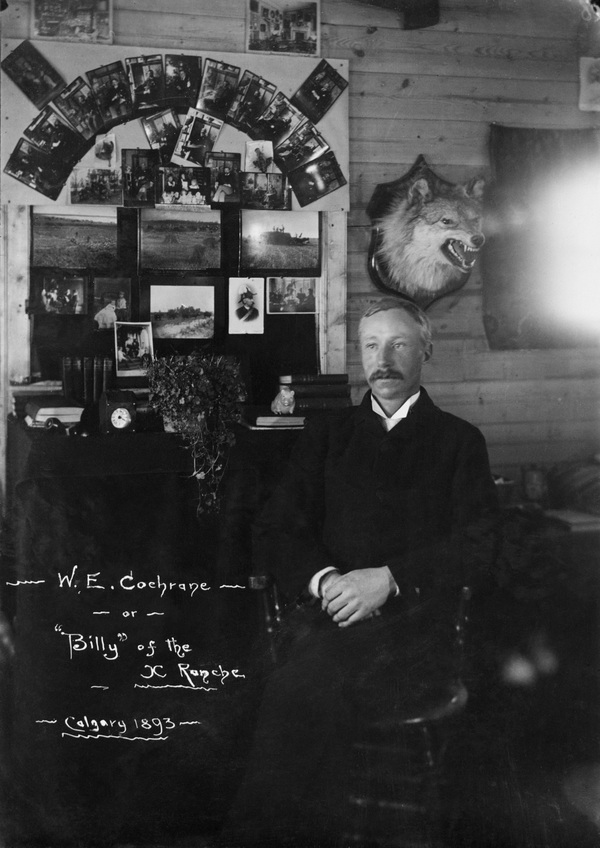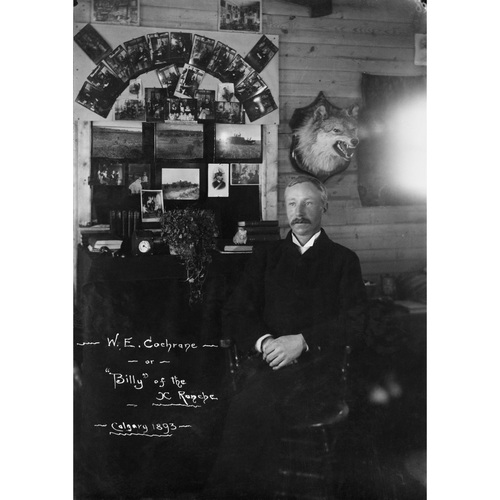
Source: Link
COCHRANE, WILLIAM EDWARD, rancher; b. 8 Sept. 1858 in Packington, near Lichfield, England, son of Basil Edward Arthur Cochrane and Sally Caroline Fitzgerald; m. 19 Feb. 1887 Evelyn Constance Clementina Lamb (d. 28 May 1908) in London, and they had one son; d. 7 March 1929 in Ballycarney (Republic of Ireland).
William E. Cochrane, known as Billy, was a grand-nephew of the famous seaman Thomas Cochrane, 10th Earl of Dundonald. Among his other relatives were Sir Thomas John Cochrane*, an early governor of Newfoundland, and Douglas Mackinnon Baillie Hamilton Cochrane*, who as the 12th Earl of Dundonald would become commander of the Canadian militia. Billy was one of a number of well-to-do young Britons who came to the Alberta foothills in the 1880s in search of adventure. He stayed to play an important part in the economic and social development of the region. Although the historiography of the Canadian range has tended to emphasize the role of four or five large corporate ranch companies [see Matthew Henry Cochrane*; Frederick Smith Stimson*], more recently it has been argued that numerous smaller family ranches buttressed the cattle industry with capital and contributed enormously to innovation and adaptation in ranching. Cochrane’s life in Alberta epitomized the achievements of this group.
The Little Bow Cattle Company, known as the CC Ranch because of its brand, was organized in 1884 by Cochrane, his cousin Thomas Belhaven Henry Cochrane, Hugh Graham, and brothers Ted and Frank Jenkins. A foundation herd of 359 head of cattle and 12 saddle-horses was imported from Montana in September 1884. A snugly sited ranch house was built on Mosquito Creek, a few miles west of Cayley. Early setbacks encouraged Billy’s partners to pursue other options and Cochrane was left the sole boss of the CC. His pride and joy was a small herd of purebred Galloway cattle. From it he raised young bulls to sell to neighbouring ranchers. They were prized for their hardihood and foraging abilities. In addition, Cochrane ran a regular range herd of about 400 cows, which yielded 220–275 calves each year. The ranch reported a total of 800 head of cattle and 40 horses in 1890.
Cochrane matured to become a conscientious and responsible rancher, always looking for ways to improve his stock and streamline production. Not only did he nurture a purebred herd on enclosed pastures, but he put up hay for calves and weak cattle from an early date. Later he pushed the stock association to keep the bulls separate from the cows until midway through the summer so that winter calving would be eliminated. Cochrane had thus brought with him attitudes towards stock rearing drawn from the British pastoral tradition. The geographer Terry G. Jordan has shown how these ideas fused with methods from the midwestern United States to ensure that ranching in the Canadian foothills differed markedly from the extensive open range methods of “the Anglo-Texan ranching complex.” Cochrane’s leadership was felt far beyond the boundaries of his ranch. For several years he organized the cowboys who rode for the Mosquito Creek Wagon at the roundup, and when his neighbour Alfred Ernest Cross* was laid up after an accident Cochrane managed the A7 Ranche for him. He was a leading figure in the fight against predators, and, in 1904, it was he who built the huge dipping vat in which all the district’s cattle were treated for mange.
Cochrane was one of a group of friends who provided capital for Cross’s Calgary Brewing and Malting Company; he purchased $1,000 of stock in 1892 and later added another $500. Perhaps more important than his financial backing was his wholehearted personal support for his friend. When Cross was sick and beset with problems in the late 1890s, Billy wrote: “It seems hard that you should chuck up now, after bearing all the expense and trouble and considerable wear and tear. . . . I am quite willing to stay with the brewery as long as you do and as long as you control the management.” The company would continue to provide Cochrane with a modest income until his death.
There was, however, another side to Billy Cochrane. One of his friends described him as having “a kiss from the devil on his cheek.” He enjoyed the physical demands of working an isolated ranch and earned the respect of his men by his willingness to turn his hand to any chore, but he expected to play as hard as he worked. During his first years in Alberta he was a leading member of the Wolves’ Den, an extremely ungentlemanly “gentlemen’s club,” which met in an old boxcar by the rail tracks in Calgary. Cochrane knew the Grant family, who produced Glen Grant Scotch whisky, and was able to ensure that there was always a barrel of ten-year-old whisky on hand to nourish their storytelling and poker games. While at their ranch, Billy and his wife, Evelyn, hunted coyotes on horseback, played and supported polo, shot and fished, and entertained frequently. Once Cochrane could rely on a trusted foreman, he adopted the habit of spending the winter in Britain, where he enjoyed fox-hunting from his family home in Leicestershire and shooting grouse in Scotland and pheasants in Dorset. The couple would also spend time in London, staying at the British Hotel, dining at the Café Royal, and catching up with the latest plays. In 1909, after Evelyn’s death, Cochrane sold his ranch and retired to Scotland. He continued to hunt and fish, and travelled widely, making frequent visits to Alberta. During World War I he falsified his age to join the 1st Sportsman’s Battalion of the Royal Fusiliers (City of London Regiment), but he did not see action. At his death his principal residence was Ravenstone Castle, near Whithorn, Scotland. He left an estate worth $1,250,000, which took some years to wind up.
Billy Cochrane displayed many of the characteristics of the reviled “remittance man.” He had a wild streak which he made no attempt to control even when he was a middle-aged family man. He expressed his support for Calgary Brewing and Malting by sampling beer copiously wherever he happened to be and then sending reports to Cross. He also made every effort to lure the overly conscientious Cross into a night or two on the town. Cochrane was a creature of his times during which money insulated the landowning class from many of the realities of life. His story is important because it demonstrates that the cultural baggage that well-off Britons brought to Alberta - customs which seemed bizarre and risible to others – in no way precluded these privileged immigrants from making substantial contributions to the settlement of what Billy often referred to as “the bald headed” prairie.
GA, M 289; M 6552. GRO, Reg. of births, Lichfield, 8 Sept. 1858; Newcastle upon Tyne, 8 Jan. 1858; Reg. of marriages, St George Hanover Square (Middlesex), 19 Feb. 1887. D. H. Breen, The Canadian prairie west and the ranching frontier, 1874-1924 (Toronto, 1983). Burke’s genealogical and heraldic history of the peerage, baronetage and knightage, ed. Peter Townend (105th ed., London, 1970). Cayley Women’s Institute, Under the chinook arch: a history of Cayley and surrounding areas ([Cayley, Alta], [1967?]). S. M. Evans et al., Cowboys, ranchers and the cattle business: cross-border perspectives on ranching history (Calgary, 2000). High River Pioneers’ and Old Timers’ Assoc., Leaves from the Medicine Tree . . . ([Lethbridge, Alta], 1960). T. G. Jordan, North American cattle ranching frontiers: origins, diffusion, and differentiation (Albuquerque, N.Mex., 1993). Sherrill MacLaren, Braehead: three founding families in nineteenth century Canada (Toronto, 1986). Nanton and District Hist. Soc., Mosquito Creek roundup: Nanton-Parkland (Nanton, Alta, 1975).
Cite This Article
Simon M. Evans, “COCHRANE, WILLIAM EDWARD,” in Dictionary of Canadian Biography, vol. 15, University of Toronto/Université Laval, 2003–, accessed April 28, 2025, https://www.biographi.ca/en/bio/cochrane_william_edward_15E.html.
The citation above shows the format for footnotes and endnotes according to the Chicago manual of style (16th edition). Information to be used in other citation formats:
| Permalink: | https://www.biographi.ca/en/bio/cochrane_william_edward_15E.html |
| Author of Article: | Simon M. Evans |
| Title of Article: | COCHRANE, WILLIAM EDWARD |
| Publication Name: | Dictionary of Canadian Biography, vol. 15 |
| Publisher: | University of Toronto/Université Laval |
| Year of revision: | 2005 |
| Access Date: | April 28, 2025 |



